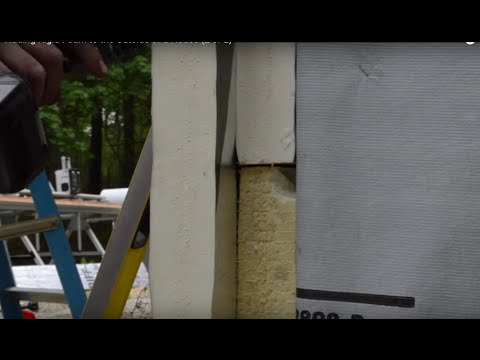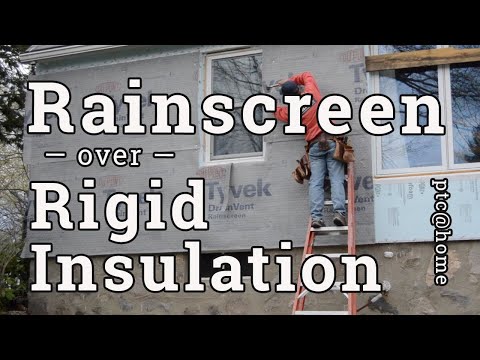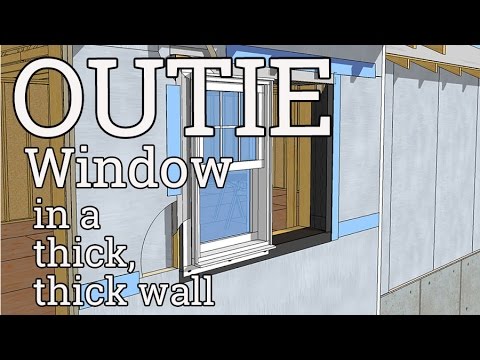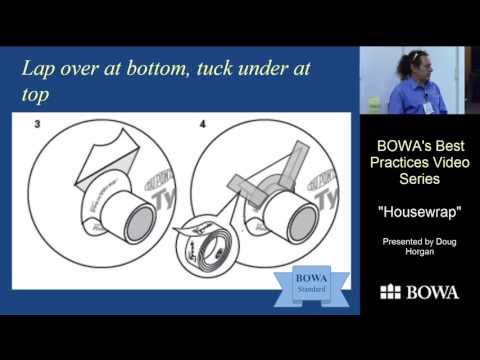In this video, we see David Joyce's details for the first layer of continuous exterior foam insulation, the bottom bug barrier, how they treat exposed edges, and a few ways to cut the foam. The transcript for this video is below, but here are the highlights.
- The windows are integrated with the housewrap and foam
- Flashing membrane spans the window, house wrap, and window flashing for an airtight assembly.
- The first layer is not the primary air barrier, so (tight) scraps are OK
- It is great to use large pieces when possible for a better air barrier, but because there is a layer of house wrap and two layers of foam, it is also safe to use up some random scraps—and there will be a lot of scraps—as long as the joints are tight and the insulation is continuous, piecing in scraps should be fine.
- Cutting foam sheets is pretty simple.
- You can use utility knives with extendable blades to get the whole depth on small cuts and when cutting sheets in place. For long cuts, you can use a knife and a chalk line or a T- square, or you can use a table saw.
- The second layer of foam is the air barrier and drainage plane.
OFFICIAL TRANSCRIPT FOR INSTALLING CONTINUOUS EXTERIOR INSULATION:
Welcome to Concord, Massachusetts. This house is undergoing a deep energy retrofit and gut rehab. To boost the R-value of the walls, 4 inches of polyisocyanurate foam is being added to the walls and roof.
The siding, a sheet product designed to mimic vertical boards, is structurally sound so it is being left in place and then covered with house wrap and foam.
The windows were installed and flashed to the openings before the house wrap, and the house wrap is sealed to the windows with flashing tape.
The windows are integrated with the housewrap and foam
Dave explains how the flashing tape connects all of the layers:
David Joyce: Our flashing membrane from the window itself, crossing the flange, right over our subflashing, and onto the house wrap.
The subflashing protects the building from any leaks that happen in the window.
How house wrap goes over that and is adhered to that ...
Which makes a good air seal and water seal. The pan flashing is extended out so that it can drain water to the outside of the foam sheathing. Extra strips of flashing tape can extend the pan flashing more.
This is where split-release sheets on the back of the tape really come in handy.
The first layer is not the primary air barrier, so (tight) scraps are OK
The two layers of foam should have offset seams, so Calvin and Damien begin with a small rip that will fit continuously under the windows. The first course is kept level to keep the measurements consistent, and a metal cap at the bottom protects the foam from insects.
It is great to use large pieces when possible, for a better air barrier, but because there is a layer of house wrap and two layers of foam, it is also safe to use up some random scraps—and there will be a lot of scraps—as long as the joints are tight and the insulation is continuous, piecing in scraps should be fine.
Editor's note:
Pieces of foam are kept in place with extra long screws and washers. On the first layer, you only need two screws per piece—to keep each piece from rotating. As a second layer is added and furring strips applied, there will be plenty of fasteners in the first layer to hold it forever.
As Dave said earlier, the foam will overlap the window frame to get a tight seal to this opening. In this case, the guys are leaving 2-1/4 inches of frame revealed. Also, at the window, they pull the pan flashing out past the foam, so that anything that leaks in is drained all the way out.
Don’t bother to tape the seams on the first layer because as you compress the foam later, the tape will be pulled away from the seams. The second layer will be taped.
As one guy installs, he can also measure for the next piece.
Working together, two installers ought to be able to keep ahead of one cut man.
Cutting polyiso foam sheets is pretty simple
You can use utility knives with extendable blades to get the whole depth on small cuts and when cutting sheets in place.
Angled cuts are needed where wall foam butts under roof foam. For long cuts, you can use a knife and a chalk line or a T- square, or you can use a table saw.
See part two of this series, Exterior Foam Insulation Retrofit: How To Install Polyiso Panels, Part 2











